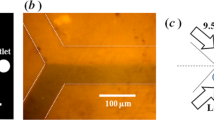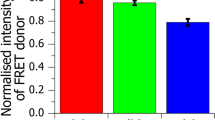Abstract
Bilayers incorporating phospholipids that are capable, in isolation, of forming non-bilayer structures show ‘pits and particles’ or ‘cusps’ by freeze-fracture electron microscopy1–6. These points of very high curvature in the bilayer have been interpreted either as inverted micelles within a single bilayer2,3 or intersecting bilayers4,5, or as intermembrane sites of attachment1,6. We have used extremely rapid freezing and cleavage at very low temperature to look at the cardiolipin–phosphatidylcholine system and report here a high incidence of cross-fractured liposomes, which shows that even at lower CaCl2 concentrations they are filled with membranous structures. More interestingly, the arrays of pits and particles are closely aligned and associated with two further kinds of asymmetric bilayer deformation. Flat areas in the bilayer seem to represent sites of particularly adherent interbilayer contact and deep imaginations appear to represent sites where fusion with internal bilayers has occurred.
This is a preview of subscription content, access via your institution
Access options
Subscribe to this journal
Receive 51 print issues and online access
$199.00 per year
only $3.90 per issue
Buy this article
- Purchase on Springer Link
- Instant access to full article PDF
Prices may be subject to local taxes which are calculated during checkout
Similar content being viewed by others
References
Miller, R. G. Nature 287, 166–167 (1980).
Verkleij, A. J., Mombers, C., Leunissen-Bijvelt, J. & Ververgaert, P. Nature 279, 162–163 (1979).
De Kruijff, B. Biochim. biophys. Acta 555, 200–209 (1979).
Verkleij, J., Mombers, C., Gerritsen, W. J., Leunissen-Bijett, L. & Cullis, P. P. Biochim. biophys. Acta 555, 358–261 (1979).
Verkleij, A. J., van Echteld, C. J. A., Gerritsen, W. J., Cullis, P. P. & de Kruijff, B. Biochim. biophys. Acta 600, 620–624 (1980).
Hui, S. W. & Stewart, T. P. Nature 290, 427–428 (1980).
Heuser, J. E. et al. J. Cell Biol. 81, 275–300 (1979).
Rand, R. P. A. Rev. Biophys. Bioengng 10, 227–314 (1981).
Parsegian, V. A., Fuller, N. & Rand, R. P. Proc. natn. Acad. Sci. U.S.A. 76, 2750–2754 (1979).
Cowley, A. D., Fuller, N. L., Rand, R. P. & Parsegian, V. A. Biochemistry 17, 3163–3168 (1978).
Szoka, F. & Papahadjopoulos, D. A. Rev. Biophys. Bioengng 9, 467–508 (1980).
Rand, R. P. & Sengupta, S. Biochim. biophys. Acta 255, 484–492 (1972).
Hui, S. W., Stewart, T. P., Boni, L. T. & Yeagle, P. L. Science 212, 921–922 (1981).
Author information
Authors and Affiliations
Rights and permissions
About this article
Cite this article
Rand, R., Reese, T. & Miller, R. Phospholipid bilayer deformations associated with interbilayer contact and fusion. Nature 293, 237–238 (1981). https://doi.org/10.1038/293237a0
Received:
Accepted:
Issue Date:
DOI: https://doi.org/10.1038/293237a0
This article is cited by
-
Junctional feet and particles in the triads of a fast-twitch muscle fibre
Journal of Muscle Research and Cell Motility (1983)
-
Induction of helical liposomes by Ca2+-mediated intermembrane binding
Nature (1982)
-
Lipidic particles and cubic phase lipids
Nature (1982)
-
Lipidic particles and cubic phase lipids (reply)
Nature (1982)
-
Evidence for the lipidic nature of tight junction strands
Nature (1982)
Comments
By submitting a comment you agree to abide by our Terms and Community Guidelines. If you find something abusive or that does not comply with our terms or guidelines please flag it as inappropriate.



